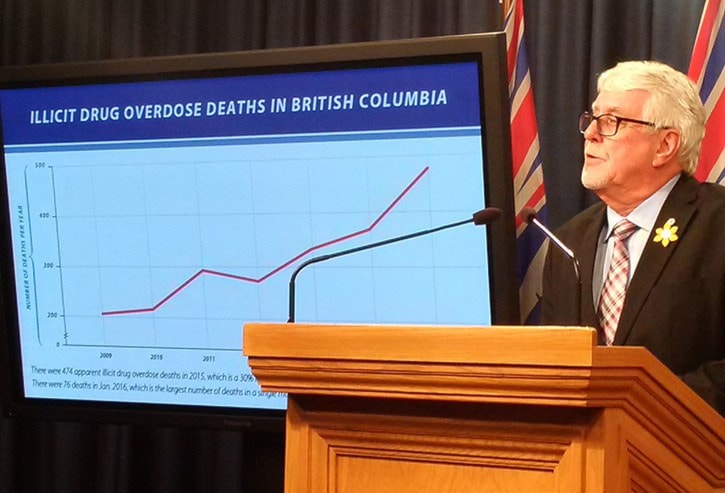White Rock and South Surrey cannot expect to remain unscathed from the current spike in fentanyl-related drug overdoses – which led the B.C. government to declare a public health emergency last week.
That’s the response from Fraser Health spokesperson Tasleem Juma following an inquiry by a Peace Arch News reader, a relative of a 24-year-old overdose victim who died at Peace Arch Hospital late in March.
The reader, who asked not to be identified, said she had heard a 23-year-old was also in intensive care at the hospital with a suspected drug overdose, the day following the death, and wondered if there had been “any bad batches of drugs making the rounds lately.”
Juma noted statistics quantifying local drug overdose cases at the hospital – and the drugs involved – are not available, and records of individual cases are a matter of patient confidentiality.
But she said it is entirely likely that Semiahmoo Peninsula drug users could be at risk from a higher presence of street-available substances including heroin and cocaine – even marijuana – that have been mixed with fentanyl, a highly potent synthetic opioid.
“The things people think they are taking are not necessarily what they are actually taking,” she warned, urging drug users, whether habitual or recreational, to exercise caution – ideally refraining from use entirely or using only with a sober companion present; someone who can be trusted to call 911 at the first sign that something is not right, or that the user may be overdosing.
“It’s all over the region,” she said.
In declaring the emergency last week, Provincial Health Officer Dr. Perry Kendall said there is no area of the province that has been unaffected by the increased level of fentanyl in street drugs, even though overdoses have mainly been concentrated in Metro Vancouver and the Fraser Valley.
There were 474 deaths as a result of apparent drug overdoses throughout B.C. in 2015 – a rise of 30 per cent over 2014.
In the Fraser Health region, there have already been 19 fentanyl-related deaths this year alone. Last year’s total for the region was 49, up sharply from 29 in 2014.
Fentanyl – 50 to 100 times more toxic than other opioids – has been found in powder sold as heroin and in counterfeit OxyContin.
Because the fentanyl may be unevenly mixed with other drugs, trying to manage the risk by reducing the quantity taken may not necessarily be safer, Fraser Health says.
Opioid overdose can cause breathing to slow or stop, causing brain damage or death. Warning signs can include severe sleepiness, slow heartbeat, trouble breathing or breathing that is slow, shallow or accompanied by snoring and cold, clammy skin, according to police.
Kits containing a life-saving antidote – naloxone – have been distributed to paramedics, firefighters and police (naloxone ‘take-home kits’ have also been widely distributed), but a drug-user’s sober ‘buddy’ can help by calling 911 quickly at any sign of adverse reaction, and by giving breath if the user becomes becomes unconscious before emergency personnel arrive.
